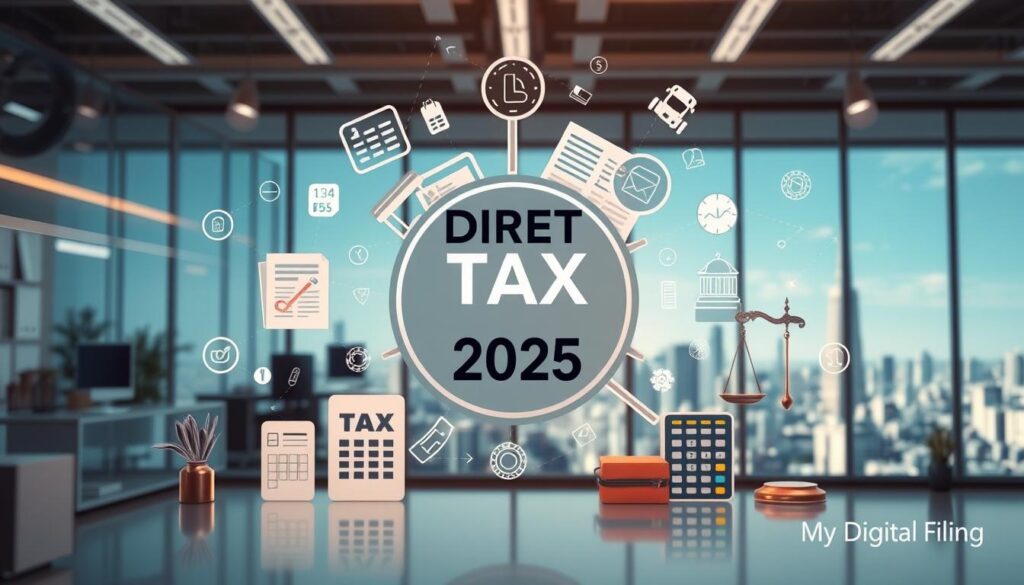Form 26QB – TDS on Sale of Property: Key Facts
Selling your property is exciting, but dealing with taxes can be tough. That’s where Form 26QB comes in. It’s important for handling the Tax Deducted at Source (TDS) on property sales in India.
According to Section 194-IA of the Income Tax Act, if you buy an immovable property for over Rs. 50 lakhs, you must deduct 1% TDS. This TDS should be paid to the government using Form 26QB within 30 days after the month it was deducted.
Key Takeaways
- Form 26QB is mandatory for TDS on property transactions exceeding Rs. 50 lakhs.
- TDS is deducted at a rate of 1% on the total sale consideration.
- Buyers and sellers must provide their PAN (Permanent Account Number) for Form 26QB.
- Form 26QB must be filed online through the Income Tax Official website.
- Timely payment of TDS is crucial to avoid penalties.
This guide will help you understand Form 26QB. It covers when and how much TDS to deduct, and how to make TDS payments and generate Form 26QB online. We aim to make the process easy for you, whether you’re selling or buying property.
What is Form 26QB?
Form 26QB is a key document for paying Tax Deducted at Source (TDS) on immovable property sales worth over Rs. 50 lakhs. Section 194-IA of the Income Tax Act says the buyer must deduct 1% TDS. This is on the total cost or the property’s stamp duty value, whichever is higher. The deducted TDS must be paid to the government using Form 26QB within 30 days after the month it was deducted.
This form helps follow TDS rules for property deals over Rs. 50 lakhs. By filling it out, the buyer meets their legal duty to deduct and pay the right TDS to the tax authorities. This helps with the tax collection process.
“Form 26QB plays a crucial role in ensuring transparency and compliance in high-value property transactions.”
Remember, TDS deduction and payment with Form 26QB only applies to property purchases over Rs. 50 lakhs. Deals under this value don’t need TDS under Section 194-IA. Knowing about Form 26QB helps property buyers meet their tax duties. It also helps them avoid fines or other issues for not following the rules.
When and How Much TDS Should be Deducted on Property Sale?
In India, TDS (Tax Deducted at Source) is needed for buying immovable property like houses, commercial spaces, and plots. This is if the total cost is Rs. 50 lakhs or more. The TDS is 1% of the total cost or the stamp duty value, whichever is higher.
Calculating TDS Amount
Let’s say a property costs Rs. 60 lakhs but the stamp duty is Rs. 65 lakhs. In this case, the TDS is based on Rs. 65 lakhs. So, the buyer must deduct and pay Rs. 65,000 (1% of Rs. 65 lakhs) using Form 26QB.
Points to Remember for Buyers and Sellers
Buyers need to keep these points in mind when deducting TDS under Section 194-IA:
- Deduct TDS at a flat rate of 1% from the total cost or stamp duty value, whichever is higher.
- Make sure to collect the seller’s PAN card for verification.
- Include both the buyer’s and seller’s PAN cards in the online Form 26QB.
Sellers should:
- Give the buyer their PAN card for TDS information to the Income Tax Department.
- Check that the buyer verifies the deducted taxes in Form 26AS.
By following these steps, both buyers and sellers can make sure TDS is deducted and paid correctly on property deals.
How to Deposit TDS with the Government using Form 26QB?
When you sell a property for more than ₹50 lakhs, you must deduct 1% of the sale amount as Tax Deducted at Source (TDS). Then, you need to deposit this TDS with the government within 30 days after the month it was deducted. This is done using Form 26QB, the challan for TDS on property sales.
Here’s a step-by-step guide on how to deposit the TDS with the government using Form 26QB:
- Log in to the Income Tax e-filing portal and go to the ‘e-pay Tax’ section.
- Select ’26QB (TDS on sale of property)’ from the ‘New payment’ options.
- Fill in the required details, including buyer and seller info, property details, tax deposit details, and contact info.
- Choose the preferred payment mode, ‘Pay later’ or ‘Pay Now’, and complete the payment.
- After the payment is processed, the Form 26QB acknowledgment can be downloaded.
Following the tds payment process and filing Form 26QB on time is key. It helps avoid penalties or interest for not following the income tax e-filing portal rules.
“Timely deduction and deposit of TDS is a legal obligation for buyers in property transactions exceeding ₹50 lakhs. Failure to comply can lead to significant penalties and interest charges.”
Process for Making TDS Payment and Generating Form 26QB Online
Making TDS payments and generating Form 26QB online is easy. The Income Tax Department has made it simpler for everyone involved in property deals. This ensures that both buyers and sellers can follow the process without trouble.
Step-by-Step Guide
Here’s how to make the TDS payment and generate Form 26QB online:
- Log in to the official Income Tax website and go to the ‘e-file’ section.
- Select ‘e-pay Tax’ and click the ‘Proceed’ button for ’26QB (TDS on sale of the property)’ in the ‘New payment’ section.
- Enter the needed details, like the buyer and seller info, property details, tax deposit info, and contact details.
- Pick how you want to pay: ‘Pay later’ or ‘Pay Now’.
- Click ‘Pay Now’ to pay the TDS amount. After payment, you’ll get the Form 26QB acknowledgment to download.
- After processing Form 26QB, the TDS Certificate (Form 16B) can be made from the TRACES Portal by logging in as a taxpayer.
The online form 26QB generation and online tds payment process through the income tax e-filing portal is smooth and efficient. By following these steps, buyers and sellers can meet their TDS duties on time and correctly.
How to Download Form 26QB?
Downloading Form 26QB is easy and can be done online through the Income Tax website. Here’s a simple guide to help you get started:
- Log in to the official Income Tax website and go to the ‘e-file’ section. Then, pick ‘e-pay taxes’.
- Choose ‘Payment history.’ If you’ve already filed Form 26QB, you’ll see it listed under ‘TDS on Sale of Property (800)’.
- Find the ‘Action’ column and click on the option to download the Form 26QB receipt or statement.
Remember, Form 26QB is a must for property buyers if the property’s value is over Rs. 50 lakh. It needs to be filed within 30 days after the month of TDS deduction. If you pay TDS late, you’ll face a 1% penalty each month until you pay up.
When downloading Form 26QB, you’ll need to provide details like the buyer’s and seller’s PAN, property address, purchase price, and TDS amount. Even if your property is worth less than Rs. 50 lakh, you still must file this form.
You can pay the TDS through net banking or credit card. The challan 280 with bank info, payment details, CIN, and a tick on 800 is your proof of payment when you choose the ‘e-tax payment immediately’ option.
Where Can the Seller View the Deducted TDS?
When a buyer deducts TDS during a property sale, the seller can see the deducted amount in their Form 26AS. This is in Part F, which is a summary of their tax details.
In Part F of Form 26AS, you’ll find the TDS certificate number and the seller’s details like name and PAN. You’ll also see the transaction date, the amount, the acknowledgment number, the deposit date, and the TDS amount.
By looking at their Form 26AS, sellers can track the TDS the buyer took out. This helps them make sure the right amount was sent to the government. It also lets them claim the right credit when they file their taxes.
| Key Information in Form 26AS | Description |
|---|---|
| TDS Certificate Number | Unique identifier for the TDS deducted and deposited |
| Deductee Name and PAN | Name and Permanent Account Number of the seller |
| Transaction Date and Amount | Date and value of the property sale transaction |
| Acknowledgment Number | Same as the number on Form 26QB |
| Date of Deposit | Date when the TDS was deposited with the government |
| TDS Amount Deposited | The actual TDS amount deducted and remitted |
By keeping an eye on their Form 26AS, sellers can make sure the TDS is shown correctly. This makes the property sale process clear and smooth.
Form 26QB – TDS on sale of Property
Form 26QB is key for depositing TDS deducted by the buyer on property purchases over Rs. 50 lakhs. It’s needed under Section 194-IA of the Income Tax Act. The buyer must deduct 1% TDS, the higher of total consideration or stamp duty value, and pay it within 30 days.
This TDS on property sales boosts income tax compliance and transparency. It makes sure the government knows about property sales and taxes paid. By deducting and depositing TDS, buyers help the government keep track of property sales.
If buyers don’t follow TDS rules, they could face penalties of Rs. 10,000 to Rs. 1 lakh. The tax department might also send a notice if TDS isn’t deducted right or filed late. This is based on data from the Annual Information Return (AIR) on property deals.
| Requirement | Details |
|---|---|
| TDS Rate | 1% of the total consideration or stamp duty value, whichever is higher |
| TDS Payment Deadline | Within 30 days from the end of the month in which the TDS was deducted |
| Applicable Transactions | Property transactions exceeding Rs. 50 lakhs |
| Penalty for Non-Filing | Rs. 10,000 to Rs. 1 lakh under Section 271H |
Form 26QB is vital for following TDS rules on property sales over Rs. 50 lakhs. Both buyers and sellers need to know the deadlines, rates, and what happens if they don’t comply. This helps avoid penalties and problems with income tax compliance.
What is TDS Form 16B?
After the buyer pays the TDS using Form 26QB, they must give the seller a TDS certificate in Form 16B. This certificate proves the TDS deducted during the property sale. To get Form 16B, the buyer just needs to follow a few easy steps.
Obtaining Form 16B
To get the TDS Form 16B, the buyer should do the following:
- Log in to the TRACES portal (www.tdscpc.gov.in).
- Navigate to the ‘Downloads’ section and select ‘Form 16B’.
- Enter the required details, such as the PAN of the seller and the acknowledgment number from Form 26QB.
- Click ‘Proceed’ to download the Form 16B certificate, which can then be given to the seller.
This TDS certificate in Form 16B proves the tax deducted at source during the property sale. The seller can then claim the tds form 16b credit against their taxes.
| Form | Purpose |
|---|---|
| Form 16 | Issued by the employer for salaried employees |
| Form 16A | Issued for non-salary income sources |
| Form 16B | Issued for TDS on property sale proceeds |
By getting the tds certificate in Form 16B, the seller can report the property sale gains accurately. They can also claim the right tax credit, making tax filing easier through the traces portal.
Determining the Amount for TDS Deduction
Calculating TDS on a property sale is simple. You look at the sale value or the stamp duty value, whichever is higher. The TDS is based on the base sale price or the stamp duty value, not the total with taxes.
Let’s say a property is sold for ₹60 lakhs, and GST is ₹6 lakhs. The TDS is calculated on the ₹60 lakhs sale price, not the total of ₹66 lakhs. This way, TDS is based on the actual sale consideration, not the total with taxes.
| Scenario | Sale Price | Stamp Duty Value | TDS Calculation |
|---|---|---|---|
| 1 | ₹60 lakhs | ₹55 lakhs | 1% of ₹60 lakhs = ₹60,000 |
| 2 | ₹55 lakhs | ₹60 lakhs | 1% of ₹60 lakhs = ₹60,000 |
The TDS is always based on the higher of the sale consideration or the stamp duty value. This protects the government’s interests and ensures a fair deal for the seller.
The TDS deduction threshold is currently ₹50 lakhs. Sales under this amount don’t need TDS. Sales over ₹50 lakhs get a 1% TDS on the total amount.
Introduction of TDS on Property Transactions
The Indian government brought in TDS on property deals under Section 194-IA of the Income Tax Act. This was to make the real estate sector more transparent. The real estate market often deals with cash and bank transactions, making it hard to track. TDS helps the government keep an eye on tds on property transactions and spot deals where properties are bought for less than their true value.
Rationale Behind the Move
The government wanted to stop tax evasion and boost income tax act section 194ia following in the real estate sector transparency. With TDS, the government can track property sales better. This ensures the right taxes are paid.
Before, the real estate market often reported sale prices too low, costing the government tax money. TDS changed this by making it harder to hide the real deal value.
“The TDS on property transactions has been a game-changer in the real estate sector, improving transparency and accountability.”
Also, TDS on property sales gives the government important data on the real estate market. This data helps make better policy decisions and understand market trends.
Consequences of Non-Compliance
Not following the TDS rules under Section 194-IA of the Income Tax Act can cause big problems for property buyers. Not following these rules can lead to big penalties and interest. It’s important for buyers to stay alert and follow the TDS rules closely.
Penalties for Non-Filing of Form 26QB
- Delaying the filing of Form 26QB can result in a daily fine of ₹200, with a cap at the deducted TDS amount.
- Not filing Form 26QB within a year can lead to a fine of ₹10,000 to ₹1,00,000 under Section 271H, plus late fees.
Penalties for TDS Non-Deduction
If a buyer doesn’t deduct the needed TDS, they could face:
- Interest at 1% per month on the undeducted amount, as per Section 201 of the Income Tax Act.
- A fine of up to ₹1,00,000 under Section 271H for not deducting TDS.
Penalties for TDS Non-Remittance
If TDS is deducted but not paid on time, the buyer could face a fine of 1.5% of the deducted amount per month until paid.
Timely filing and accurate details in Form 26QB are key to avoiding penalties and ensuring smooth transactions, as advised by CA Gaurav Agarwal.
Buyers must be careful with the TDS rules to avoid these big fines and interest. Not following them can greatly affect the financial outcome of buying property.
Notice for Non-Filing of Form 26QB
The Income Tax Department keeps an eye on property deals through the Annual Information Return (AIR). If a buyer doesn’t take out the needed 1% Tax Deducted at Source (TDS) or doesn’t file Form 26QB on time, they’ll get a notice.
Sample Notice from IT Department
The notice will tell the buyer they didn’t file Form 26QB for their property buy. It will have important info like:
- Details of the property deal, including the sale price and the purchase date
- The TDS amount that should have been taken out and paid to the government
- The penalties and interest for not following the rules
- A deadline to fix the issue
If you ignore the notice or don’t fix the problem, you could face more penalties and legal trouble. It’s key for buyers to make sure they take out the right TDS and file Form 26QB on time to dodge these problems.
“Not filing Form 26QB can bring penalties of up to Rs. 1 lakh, plus interest. Buyers must know their TDS duties to avoid these outcomes.”
The Income Tax Department is very serious about the non-filing of form 26QB. It’s a key part of the annual information return process. Buyers who get an income tax department notice must act fast to fix the issue and prevent more penalties.
Key Changes in Budget 2024
The Finance Minister’s Budget 2024 brought two big updates on TDS for property deals in India. These changes aim to make TDS easier for buyers and sellers to follow.
Clarification on TDS filing: Before, there was confusion over filing TDS (Form 26QB) if each buyer and seller’s share was under Rs. 50 lakhs. Budget 2024 has made it clear that buyers must file TDS (Form 26QB) if the property’s total value is over Rs. 50 lakhs. This rule starts from October 1, 2024.
No change in TDS rate: The TDS rate for property deals under Section 194-IA stays at 1%. This is the same as before. It means there’s no change for buyers and sellers in the real estate market.
| Change | Details |
|---|---|
| Clarification on TDS filing | TDS (Form 26QB) must be filed if the total property value exceeds Rs. 50 lakhs, even if the individual share is less than Rs. 50 lakhs. |
| TDS rate | The TDS rate on property transactions remains at 1% of the total consideration or stamp duty value, whichever is higher. |
These updates in the budget 2024 aim to make TDS easier for tds on property transactions. They provide more clarity for buyers and sellers in the real estate market.
Conclusion
Form 26QB is key for buyers when they buy a property worth over Rs. 50 lakhs. It’s where they put the 1% TDS taken from the seller. Not following this rule can result in fines and extra charges. Knowing about form 26qb, tds on property sale, and income tax compliance helps buyers and sellers have a smooth deal.
It’s important to file Form 26QB within 30 days after the month the tax was deducted. If you’re late, you’ll face a Rs. 200 daily fine. Not filing it at all can cost you Rs. 10,000, as per Section 271H of the Income Tax Act.
For a smooth deal, both buyers and sellers must know their roles and follow the form 26qb, tds on property sale, and income tax compliance rules. Being informed and following the rules helps avoid problems and makes buying property less stressful.
FAQ
What is Form 26QB?
Form 26QB is a challan for paying Tax Deducted at Source (TDS) by the buyer. This is for the purchase of an immovable property worth Rs. 50 lakhs or more. It’s required under Section 194-IA of the Income Tax Act.
When and how much TDS should be deducted on a property sale?
TDS under Section 194-IA needs to be deducted at 1% of the total consideration or the stamp duty value. This is whichever is higher. The buyer must deduct and deposit the TDS within 30 days from the end of the month it was deducted.
How do I deposit TDS with the government using Form 26QB?
Deposit the TDS with the government using Form 26QB within 30 days from the end of the month it was deducted. Log in to the Income Tax e-filing portal, go to the ‘e-pay Tax’ section, and choose ’26QB (TDS on sale of property)’ from the ‘New payment’ options.
How do I generate Form 26QB online?
To generate Form 26QB online, follow these steps: Log in to the Income Tax e-filing portal, select ‘e-pay Tax’, and click ‘Proceed’ for ’26QB (TDS on sale of property)’ in the ‘New payment’ section. Then, fill in the required details, choose the payment mode, and complete the payment to get the Form 26QB acknowledgment.
Where can I download Form 26QB?
Download Form 26QB by logging in to the Income Tax website, going to the ‘e-file’ section, selecting ‘e-pay taxes’, and choosing ‘Payment history’. If you’ve already filed Form 26QB, find it under ‘TDS on Sale of Property (800)’ in the ‘Action’ column, and download the receipt or statement.
Where can the seller view the deducted TDS?
The deducted TDS will show up in the seller’s Form 26AS, in Part F. This section lists the TDS certificate number, the deductee’s name and PAN, the transaction date and amount, the acknowledgment number, the deposit date, and the TDS amount deposited.
What is TDS Form 16B, and how can I obtain it?
After using Form 26QB for depositing TDS, the buyer must give the seller a TDS certificate in Form 16B. To get Form 16B, log in to the TRACES website, go to the ‘Downloads’ section, select ‘Form 16B’, enter the details, and download the certificate for the seller.
How is the TDS amount calculated?
TDS under Section 194-IA is deducted based on the sale value or stamp duty value, not the total value including taxes. For example, if a property is sold for Rs. 60 lakhs and GST of Rs. 6 lakhs is added, the TDS is calculated on Rs. 60 lakhs, not Rs. 66 lakhs.
Why was TDS on property transactions introduced?
TDS on property transactions was introduced to make the real estate sector more transparent. The market is often speculative, with transactions involving cash and banking channels. This requirement helps the government track property deals and spot instances where properties are bought for less than their stamp duty value.
What are the consequences of non-compliance with TDS requirements?
Not following the TDS rules under Section 194-IA can lead to several issues for the buyer. These include paying interest at 1% on the undeducted amount, a penalty up to Rs. 1,00,000, and a 1.5% monthly penalty on the deducted amount for not paying the TDS. Delayed filing of TDS returns can also result in a Rs. 200 daily penalty.
What key changes were announced in Budget 2024 related to TDS on property transactions?
Budget 2024 brought changes like clarifying that buyers must file TDS (Form 26QB) if the property’s total value is over Rs. 50 lakhs, even if each share is under Rs. 50 lakhs. The TDS rate remains at 1% of the total consideration or stamp duty value, whichever is higher.









